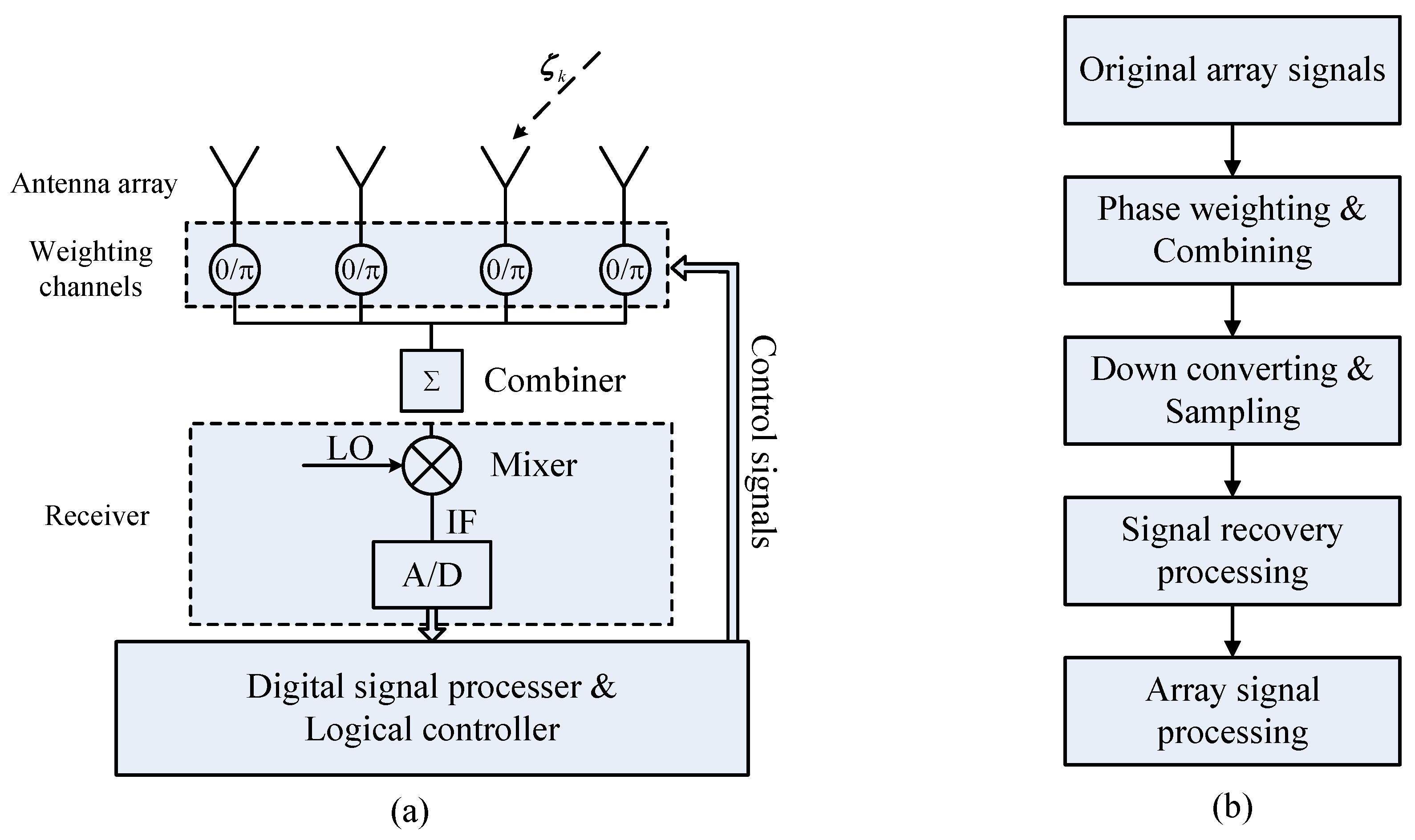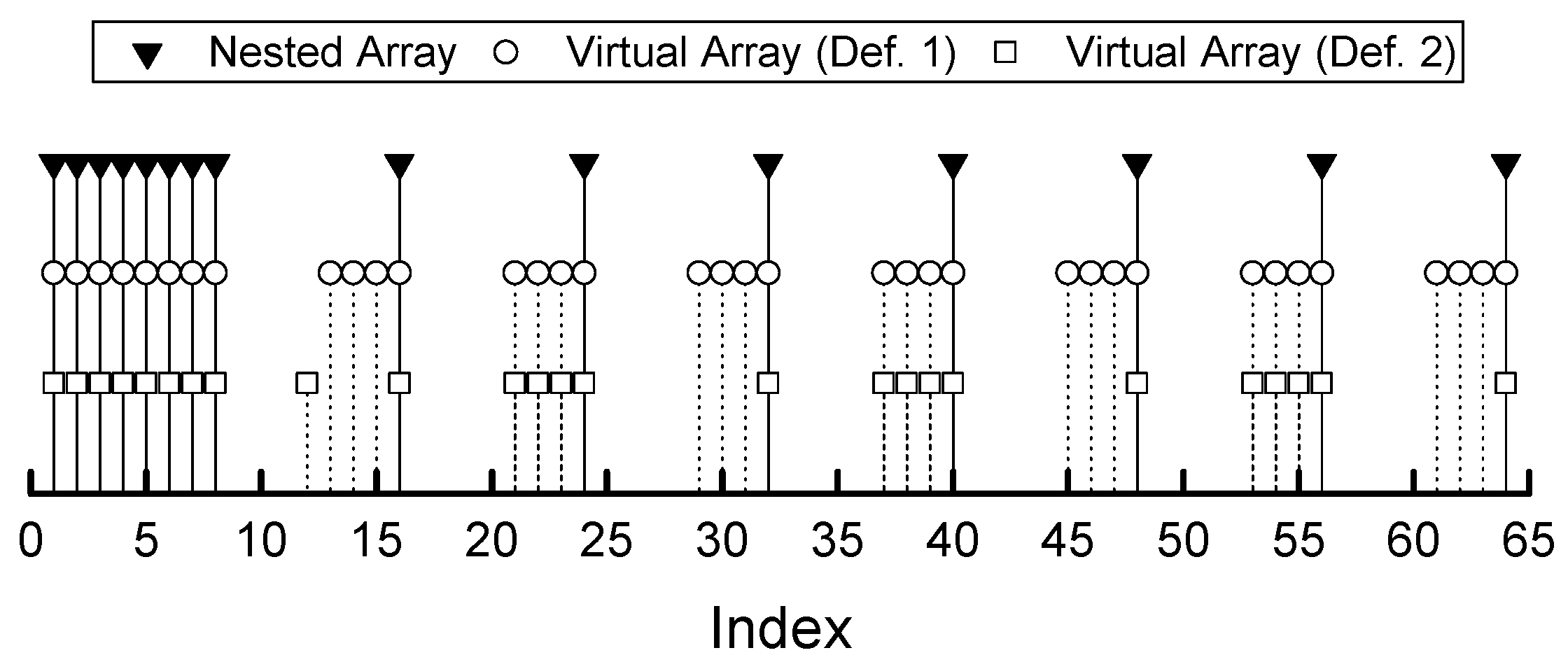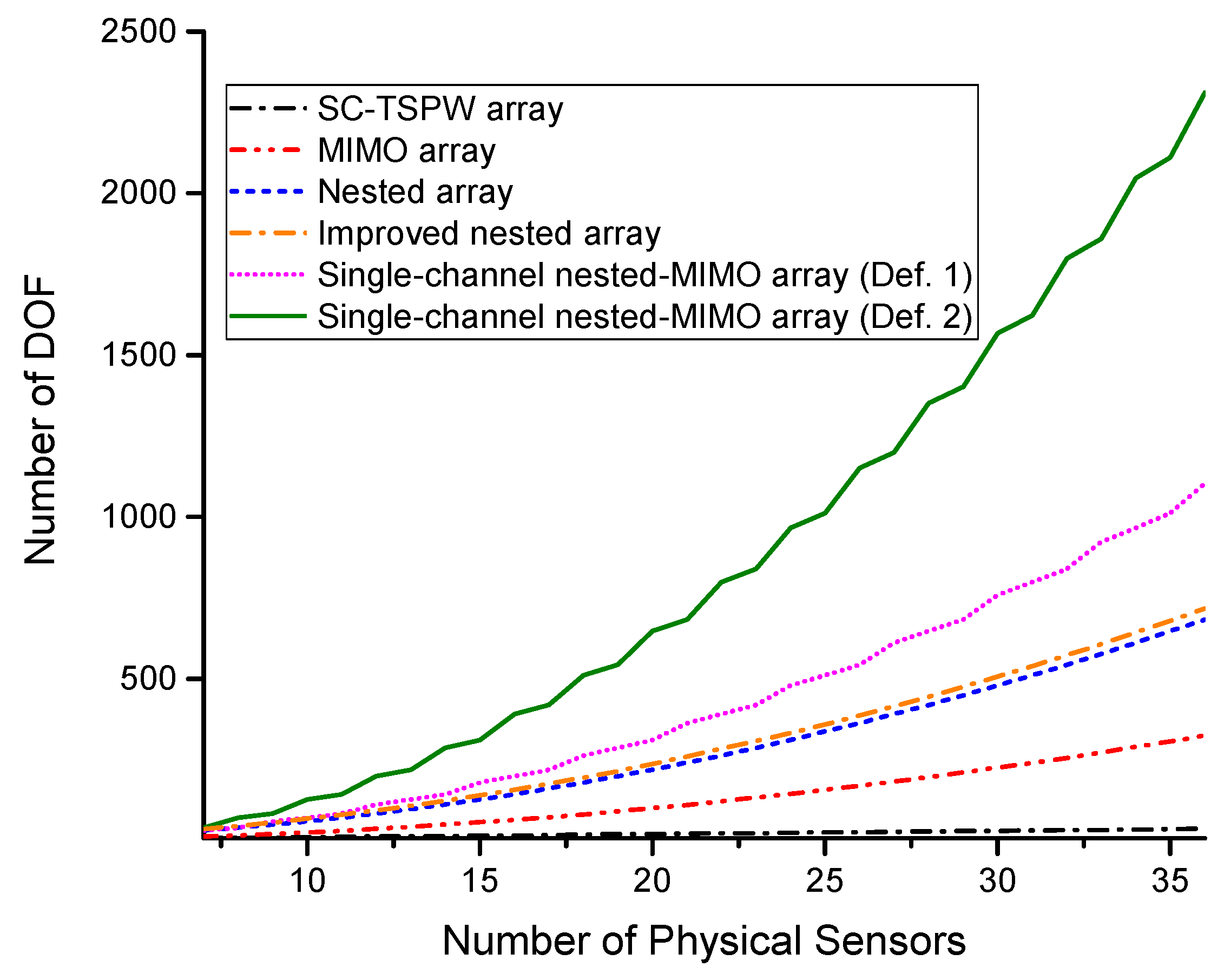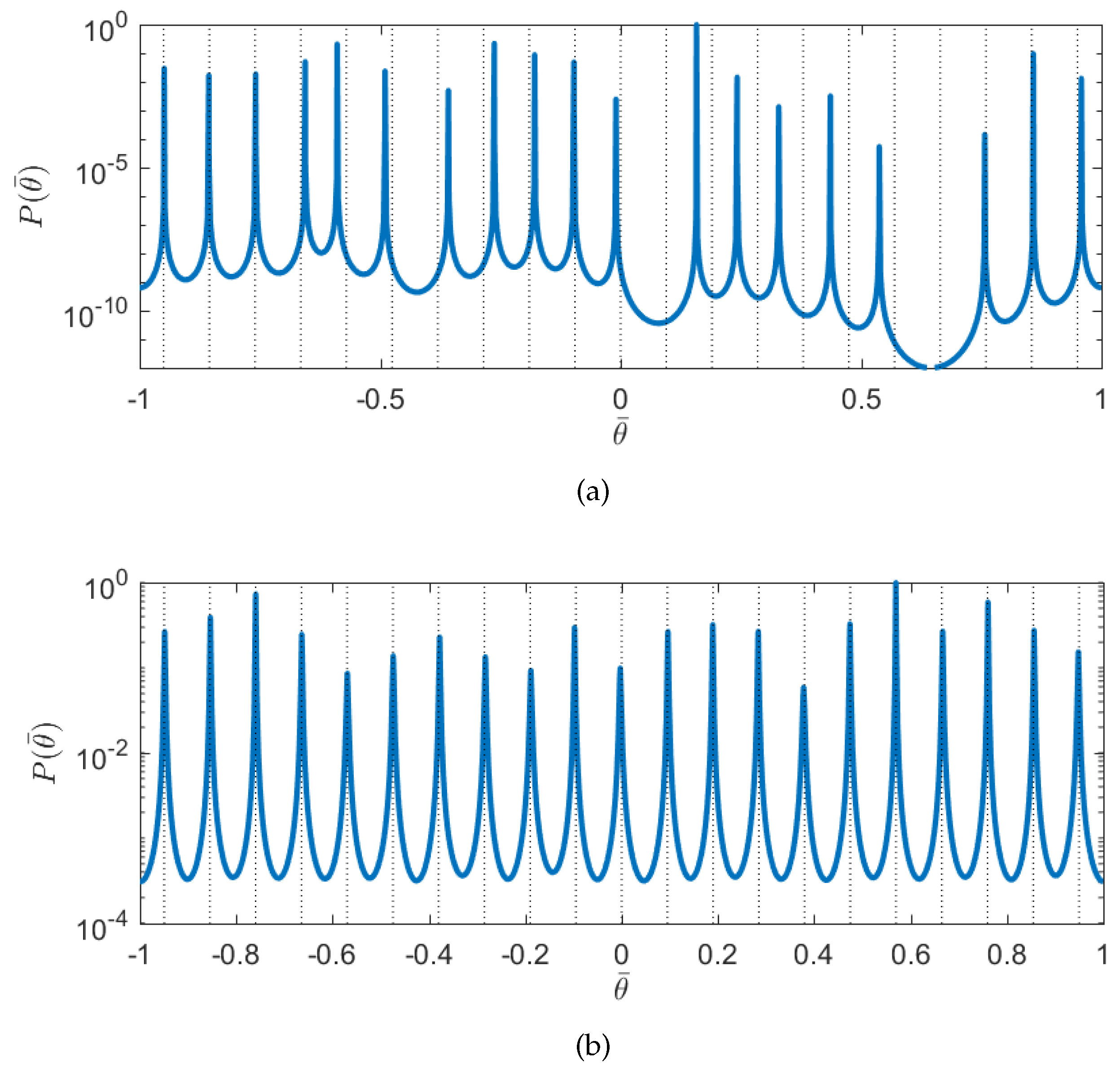Low-Cost Nested-MIMO Array for Large-Scale Wireless Sensor Applications
Abstract
:1. Introduction
2. Related Work
- The transmit antenna array is introduced into the conventional SC-TSPW array. Different waveforms transmitted by different antennas are exploited. The aperture size of the corresponding virtual array can be effectively extended. Specifically, since only one set of receiving equipment is required, the hardware cost is reduced compared with that of the frequently-used multichannel system. This low-cost feature is useful for those cost-sensitive applications, such as low-cost personal mobile radar [27,28], next generation wireless systems [29], millimeter-wave automotive radar [30], and so on.
- The work compromises the merits of the nested array and the MIMO array. The sensor locations of the proposed array have closed-form expressions. We prove with mathematic analysis that the virtual array of the proposed single channel nested-MIMO array can fully cover a parent nested array. The aperture size and number of DOF can be predicted as a function of the total number of sensors. Additionally, for a given number of DOF, the number of total sensors is relatively small.
- The corresponding signal recovery method of the single channel nested-MIMO array is proposed. Unlike the recovery method, which uses the single channel samplings that contain only one kind of waveform, the proposed signal recovery method uses the single channel samplings, which contains different orthogonal waveforms, to form a virtual array with a large aperture. For a given number of DOF, it requires less processing time than that of the conventional SC-TSPW array.
3. Preliminaries
3.1. Single-Channel TSPW Array
3.2. Multi-Channel MIMO Array
3.3. Nested Array
4. Single-Channel Nested-MIMO Array
4.1. Array Geometry of Single-Channel Nested-MIMO Array
- If is an odd integer, and is an even integer:In this case, the number of sensors of the parent nested-array N is an odd integer and the number of physical sensors of the nested-MIMO array is an even integer. Then:
- If both and are even integers:In this case, the number of sensors of the parent nested-array N is an even integer, and the number of physical sensors of the nested-MIMO array is an odd integer. Then:
- If is an even integer and is an odd integer:In this case, the number of sensors of the parent nested-array N is an odd integer, and the number of physical sensors of the nested-MIMO array is an even integer. Then:
- If both and are odd integers:In this case, the number of sensors of the parent nested-array N is an even integer and the number of physical sensors of the nested-MIMO array is an even integer. Then:Thus, the maximal number of DOF that the nested-MIMO array can provide is:Q.E.D. ☐
4.2. Signal Processing of Single Channel Nested-MIMO Array
5. Simulation Results
6. Conclusions
Acknowledgments
Author Contributions
Conflicts of Interest
Abbreviations
| TSPW | time-sequence-phase-weighting |
| MIMO | multiple-input multiple-output |
| DOF | degrees of freedom |
| CDMA | code division multiple access |
| DCA | difference co-array |
| NMRA | nested minimum redundancy array |
| SS-MUSIC | spatial smoothing multiple signal classification |
| RMSE | root mean square error |
| SNR | signal to noise ratio |
| SC-TSPW | single channel TSPW |
| SC-MIMO | single channel MIMO |
| SC-NA | single channel nested array |
References
- Alrabadi, O.N.; Perruisseau-Carrier, J.; Kalis, A. MIMO transmission using a single RF source: Theory and antenna design. IEEE Trans. Antennas Propag. 2012, 60, 654–664. [Google Scholar] [CrossRef]
- Wang, X.; Wang, W.; Li, X.; Liu, Q.; Liu, J. Sparsity-aware DOA estimation scheme for noncircular source in MIMO radar. Sensors 2016, 16, 539. [Google Scholar] [CrossRef] [PubMed]
- Wang, W.Q. Large-area remote sensing in high-altitude high-speed platform using MIMO SAR. IEEE J. Sel. Topics Appl. Earth Observ. Remote Sens. 2013, 6, 2146–2158. [Google Scholar] [CrossRef]
- Gao, H.; Wang, J.; Jiang, C.; Zhang, X. Antenna allocation in MIMO radar with widely separated antennas for multi-target detection. Sensors 2014, 14, 20165–20187. [Google Scholar] [CrossRef] [PubMed]
- Hassan, N.; Raahemifar, K.; Fernando, X. Least square optimization of pilot sequence length for massive MIMO systems. In Proceedings of the Computer Aided Modelling and Design of Communication Links and Networks, Toronto, ON, Canada, 23–25 October 2016. [Google Scholar]
- Bliss, D.W.; Forsythe, K.W. Multiple-input multiple-output (MIMO) radar and imaging: Degrees of freedom and resolution. In Proceedings of the Thrity-Seventh Asilomar Conference on Signals, Systems & Computers, Pacific Grove, CA, USA, 9–12 November 2003. [Google Scholar]
- Geng, Z.; Deng, H. Adaptive interference and clutter rejection processing for bistatic MIMO radar. In Proceedings of the 2016 IEEE International Symposium on Antennas and Propagation, Fajardo, Puerto Rico, 26 Junuary–1 July 2016. [Google Scholar]
- Li, J.; Stoica, P.; Xu, L.; Roberts, W. On parameter identifiability of MIMO radar. IEEE Signal Process Lett. 2007, 14, 968–971. [Google Scholar]
- Tzeng, F.; Jahanian, A.; Pi, D.; Heydari, P. A CMOS code-modulated path-sharing multi-antenna receiver front-end. IEEE J. Sol. State Circuits 2009, 44, 1321–1335. [Google Scholar] [CrossRef]
- Björnson, E.; Matthaiou, M.; Debbah, M. Massive MIMO with non-ideal arbitrary arrays: hardware scaling laws and circuit-aware design. IEEE Trans. Wireless Commun. 2015, 14, 4353–4368. [Google Scholar] [CrossRef]
- Zhang, J.D.; Wu, W.; Fang, D.G. Single RF channel digital beamforming multibeam antenna array based on time sequence phase weighting. IEEE Antennas Wirel. Propag. Lett. 2011, 10, 514–516. [Google Scholar] [CrossRef]
- Zhang, D.; Wu, W.; Fang, D.G. Array signal recovery algorithm for a single-RF-channel DBF array. EURASIP J. Adv. Signal Process. 2016, 2016, 99. [Google Scholar] [CrossRef]
- Hong, W.; Baek, K.H.; Lee, Y.; Kim, Y.; Ko, S.T. Study and prototyping of practically large-scale mmWave antenna systems for 5G cellular devices. IEEE Commun. Mag. 2014, 52, 63–69. [Google Scholar] [CrossRef]
- Pan, X.; Jiang, J.; Wang, N. Evaluation of the performance of the distributed phased-MIMO sonar. Sensors 2017, 17, 133. [Google Scholar] [CrossRef] [PubMed]
- Guidi, F.; Guerra, A.; Dardari, D. Personal mobile radars with millimeter-wave massive arrays for indoor mapping. IEEE Trans. Mob. Comput. 2016, 15, 1471–1484. [Google Scholar] [CrossRef]
- Pal, P.; Vaidyanathan, P.P. Nested arrays: A novel approach to array processing with enhanced degrees of freedom. IEEE Trans. Signal Process. 2010, 58, 4167–4181. [Google Scholar] [CrossRef]
- Moffet, A. Minimum-redundancy linear arrays. IEEE Trans. Antennas Propag. 1968, 16, 172–175. [Google Scholar] [CrossRef]
- Vertatschitsch, E.; Haykin, S. Nonredundant arrays. Proc. IEEE 1986, 74, 217. [Google Scholar] [CrossRef]
- Liu, C.L.; Vaidyanathan, P.P. Super nested arrays: Linear sparse arrays with reduced mutual coupling-part I: fundamentals. IEEE Trans. Signal Process. 2016, 64, 3997–4012. [Google Scholar] [CrossRef]
- Wang, H.; Fang, D.G.; Li, M. A single channel microstrip electronic tracking antenna array with time sequence phase weighting on sub-array. IEEE Trans. Microwave Theory Tech. 2010, 58, 253–258. [Google Scholar] [CrossRef]
- Noordin, N.H.; Arslan, T.; Flynn, B.W.; Erdogan, A.T.; El-Rayis, A.O. Single-port beamforming algorithm for 3-faceted phased array antenna. IEEE Antennas Wirel. Propag. Lett. 2013, 12, 813–816. [Google Scholar] [CrossRef]
- Qin, S.; Zhang, Y.D.; Amin, M.G. DOA estimation of mixed coherent and uncorrelated signals exploiting a nested MIMO system. In Proceedings of the 2014 IEEE Benjamin Franklin Symposium on Microwave and Antenna Sub-systems for Radar, Telecommunications, and Biomedical Applications, Philadelphia, PA, USA, 26 September 2014. [Google Scholar]
- Jie, Y.; Gui-sheng, L. A spatial sparsity-based DOA estimation method in nested MIMO radar. J. Electron. 2014, 36, 2698–2704. [Google Scholar]
- Chun-Yang, C.; Vaidyanathan, P.P. Minimum redundancy MIMO radars. In Proceedings of the 2008 IEEE International Symposium on Circuits and Systems, Seattle, WA, USA, 18–21 May 2008. [Google Scholar]
- Yangg, M.; Haimovich, A.M.; Chen, B.; Yuan, X. A new array geometry for DOA estimation with enhanced degrees of freedom. In Proceedings of the 2016 IEEE International Conference on Acoustics, Speech and Signal Processing, Shanghai, China, 20–25 March 2016. [Google Scholar]
- Zhu, C.; Chen, H.; Shao, H. Joint phased-MIMO and nested-array beamforming for increased degrees-of- freedom. Int. J. Antennas Propag. 2015, 2015, 11. [Google Scholar] [CrossRef]
- Guidi, F.; Guerra, A.; Dardari, D. Millimeter-wave massive arrays for indoor SLAM. In Proceedings of the 2014 IEEE International Conference on Communications Workshops, Sydney, Australia, 10–14 Junuary 2014. [Google Scholar]
- Guerra, A.; Guidi, F.; Dardari, D. Millimeter-wave personal radars for 3D environment mapping. In Proceedings of the 2014 48th Asilomar Conference on Signals, Systems and Computers, Pacific Grove, CA, USA, 2–5 November 2014. [Google Scholar]
- Larsson, E.G.; Edfors, O.; Tufvesson, F.; Marzetta, T.L. Massive MIMO for next generation wireless systems. IEEE Commun. Mag. 2014, 52, 186–195. [Google Scholar] [CrossRef]
- Menzel, W.; Moebius, A. Antenna concepts for millimeter-wave automotive radar sensors. Proc. IEEE 2012, 100, 2372–2379. [Google Scholar] [CrossRef]
- Wei-Xing, S.; Da-Gang, F. Angular superresolution for phased antenna array by phase weighting. IEEE Trans. Aerosp. Electron. Syst. 2001, 37, 1450–1814. [Google Scholar] [CrossRef]
- Richards, M.A. Fundamentals of Radar Signal Processing; Tata McGraw-Hill Education: Noida, India, 2005. [Google Scholar]
- Haimovich, A.M.; Blum, R.S.; Cimini, L.J. MIMO radar with widely separated antennas. IEEE Signal Process Mag. 2008, 25, 116–129. [Google Scholar] [CrossRef]
- Li, J.; Stoica, P. MIMO radar with colocated antennas. IEEE Signal Process Mag. 2007, 24, 106–114. [Google Scholar] [CrossRef]
- He, Q.; Blum, R.S.; Godrich, H.; Haimovich, A.M. Target velocity estimation and antenna placement for MIMO radar with widely separated antennas. IEEE J. Sel. Top. Signal Process. 2010, 4, 79–100. [Google Scholar] [CrossRef]
- Hassanien, A.; Vorobyov, S.A. Transmit energy focusing for DOA estimation in MIMO radar with colocated antennas. IEEE Trans. Signal Process. 2011, 59, 2669–2682. [Google Scholar] [CrossRef]
- Skolnik, M. Radar Handbook Third Edition; Tata McGraw-Hill Education: Noida, India, 2008. [Google Scholar]
- Li, S.; Xie, D. Compressed symmetric nested arrays and their application for direction-of-arrival estimation of near-field sources. Sensors 2016, 16, 1939. [Google Scholar] [CrossRef] [PubMed]
- Qin, S.; Zhang, Y.D.; Amin, M.G. Generalized coprime array configurations for direction-of-arrival estimation. IEEE Trans. Signal Process. 2015, 63, 1377–1390. [Google Scholar] [CrossRef]
- Chen, C.Y.; Vaidyanathan, P.P. MIMO radar space-time adaptive processing using prolate spheroidal wave functions. IEEE Trans. Signal Process. 2008, 56, 623–635. [Google Scholar] [CrossRef]
- Han, K.; Nehorai, A. Improved source number detection and direction estimation with nested arrays and ULAs using jackknifing. IEEE Trans. Signal Process. 2013, 61, 6118–6128. [Google Scholar] [CrossRef]










| 1 | ⋯ | |||||||
| 1 | 1 | ⋯ | ||||||
| ⋮ | ⋮ | ⋮ | ⋮ | ⋮ | ⋮ | ⋱ | ⋮ | |
| ⋯ | ||||||||
| ⋯ | ||||||||
| ⋯ | ||||||||
© 2017 by the authors. Licensee MDPI, Basel, Switzerland. This article is an open access article distributed under the terms and conditions of the Creative Commons Attribution (CC BY) license (http://creativecommons.org/licenses/by/4.0/).
Share and Cite
Zhang, D.; Wu, W.; Fang, D.; Wang, W.; Cui, C. Low-Cost Nested-MIMO Array for Large-Scale Wireless Sensor Applications. Sensors 2017, 17, 1105. https://doi.org/10.3390/s17051105
Zhang D, Wu W, Fang D, Wang W, Cui C. Low-Cost Nested-MIMO Array for Large-Scale Wireless Sensor Applications. Sensors. 2017; 17(5):1105. https://doi.org/10.3390/s17051105
Chicago/Turabian StyleZhang, Duo, Wen Wu, Dagang Fang, Wenqin Wang, and Can Cui. 2017. "Low-Cost Nested-MIMO Array for Large-Scale Wireless Sensor Applications" Sensors 17, no. 5: 1105. https://doi.org/10.3390/s17051105
APA StyleZhang, D., Wu, W., Fang, D., Wang, W., & Cui, C. (2017). Low-Cost Nested-MIMO Array for Large-Scale Wireless Sensor Applications. Sensors, 17(5), 1105. https://doi.org/10.3390/s17051105






